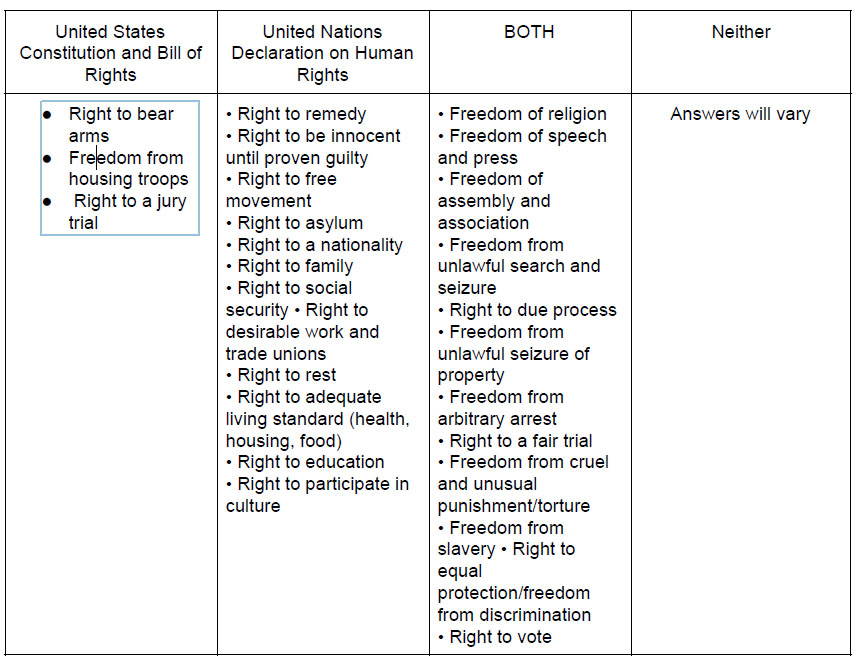Students will compare and contrast the United States Bill of Rights and the United Nations Universal Declaration of Human Rights.
Recognize important issues related to the struggle to protect human rights historically and in current times
Students will explore reasons for the presence or absence of certain rights and to reflect on the role of government/governing bodies in guaranteeing rights.
I thoroughly enjoyed the presentation on Eleanor Roosevelt and her role at the United Nations conference and the creation of the Declaration on Human Rights.
Amazing story of Eleanor Roosevelt and the committee bringing in human rights views from around the world.
Define what rights we have as humans and determine how those rights could be taken away or suppressed.
Compare and contrast the Universal Declaration of Human Rights to those in the United States Bill of Rights
Select what rights they feel are the most important to them and their lives.
2. Continuity and change in the history of Missouri, the United States and the world
6. Relationships of the individual and groups to institutions and cultural traditions
7. The use of tools of social science inquiry (such as surveys, statistics, maps, documents)
2aD Describe and evaluate the evolution of the United States domestic and foreign policy including the Cold War.
2bG Examine the wars of the 20th century, including: causes, comparisons, consequences, and peace efforts.
3B Compare and contrast governmental systems, current and historical, including those that are democratic and totalitarian.
7B Distinguish between primary and secondary sources.
Textbook
Classroom notes
Constitution• National Archives - http://www.archives.gov/exhibits/charters/constitution_transcript.html
Bill of Rights• National Archives - http://www.archives.gov/exhibits/charters/bill_of_rights.html
League of Nations Covenant• Yale Law School - http://avalon.law.yale.edu/20th_century/leagcov.asp
United Nations Charter•United Nations website - http://www.un.org/en/documents/charter/
United Nations Declaration on Human Rights• - http://www.supremecourt.ge/files/upload-file/pdf/act3.pdf
Internet
The UDHR lists the rights that all people around the world should have.
In the United States, the Constitution and Bill of Rights describe and protect the human rights of all people in this country.
The two documents have a similar purpose and protect some of the same rights, but there are many differences.
Students will use the above links to the primary sources for this lesson.
Students will use the links to access the following primary sources: Link #1 US Constitution, Link #2 US Bill of Rights,
Link #3 League of Nations Covenant, Link #4 United Nations Charter, and Link #5 United Nations Declaration of Human Rights.
(Links #3 and #4 can be used for historical information or not used at all).
They will need to identify which rights are listed in the UDHR and which are listed in the U.S. Constitution.
Students may also feel that some things which should be rights are not listed in either document – these can be added to the fourth column.
Directions: use the primary sources to fill in the table below. Rights found ONLY in the U.S. Constitution should go in column 1,
while rights found ONLY in the Universal Declaration of Human Rights should go in column 2.
Some rights are found in both the Constitution and the UDHR – list these in column 3.
Finally, you may feel there are rights that should be protected but which are not in either document. Write these in column 4.
| United States Constitution and Bill of Rights |
United Nations Declaration on Human Rights |
BOTH |
NEITHER |
|
|

1. Were there any rights included in either the Constitution or the UDHR that surprised you?
2. Would you add any rights to the Constitution? Would you add any to the UDHR?
3. Which ones?
4. Are there any rights that you think do not belong in either the Constitution or the UDHR or both? Why?
